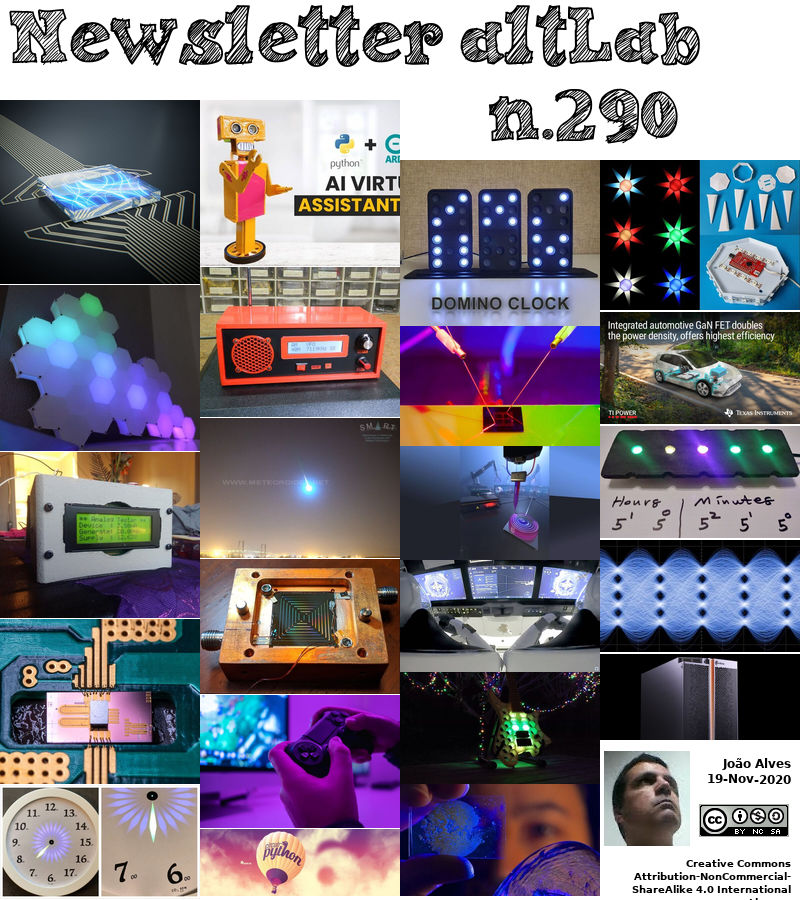2020-11-19 - Nº 290
Editorial
Esta é a Newsletter Nº 290 que se apresenta com o mesmo formato que as anteriores. Se gostar da Newsletter partilhe-a!
Todas as Newsletters encontram-se indexadas no link.
Esta Newsletter tem os seguintes tópicos:
Faz hoje anos que nascia, em 1918, o astrónomo holandês Hendrik C. van de Hulst. Ele previu teoricamente que no espaço interestelar a quantidade de hidrogénio atómico neutro, que em sua transição hiperfina irradia e absorve a um comprimento de onda de 21 cm, pode-se esperar que ocorra em densidades de coluna tão altas a ponto de fornecer uma linha espectral suficientemente forte a ponto de ser mensurável. A linha de 21 cm de hidrogénio atómico foi detectada em 1951, a primeira na Universidade de Harvard seguida em poucas semanas por outros. A descoberta demonstrou que a pesquisa astronómica, que naquela época era limitada à luz convencional, poderia ser complementada com observações em comprimentos de onda de rádio, revelando uma série de novos processos físicos.
Faz igualmente hoje anos que nascia, em 1922, o geofísico britânico Keith Runcorn. Ele foi o primeiro a descobrir evidências das inversões polares periódicas do campo magnético da Terra. Na década de 1950 ele foi um pioneiro na disciplina incipiente do paleomagnetismo, ou magnetismo remanente, o estudo do magnetismo residual. Ele também fez contribuições substanciais para vários campos, incluindo convecção na Terra e Lua, a forma e campos magnéticos da Lua e planetas, magnetohidrodinâmica do núcleo da Terra, correntes terrestres, mudanças na duração do dia e divagação polar, deriva continental e tectónica de placas.
Por fim, faz hoje anos que nascia, em 1936, o químico taiwanês-americano Yuan T. Lee. Ele repartiu (com Dudley R. Herschbach e John C. Polanyi) o Prémio Nobel de Química em 1986 pelo seu papel no desenvolvimento da dinâmica da reacção química. Como investigador de pós-doutorado, Lee experimentou e desenvolveu a invenção de Herschbach da “técnica de feixe molecular cruzado”. Este estudo analisou reacções entre moléculas em baixas pressões, permitindo que feixes de moléculas e / ou átomos se encontrassem num ponto no espaço. Lee estendeu a técnica de Herschbach, introduzindo a espectroscopia de massa para identificar os produtos resultantes das reacções dos átomos de oxigénio e flúor com compostos orgânicos complexos.
Nesta semana que passou a cápsula Dragon da SpaceX chegou à Estação Espacial Internacional. Depois de ter sido lançada no passado dia 15 no foguetão SpaceX Falcon 9 os quatro astronautas, três norte-americanos e um japonês chegaram em segurança. Esta missão é a primeira de seis certificadas, as missões da tripulação NASA e SpaceX vão voar como parte do Programa de Tripulação Comercial da agência.
Também esta semana foi noticia uma "bola de fogo" que atravessou os céus do sul de Portugal e Espanha na madrugada da passada segunda-feira. O objecto calcula-se que se deslocava a uma velocidade de 227 mil quilómetros e destruiu-se a cerca de 61 quilómetros de altura sobre o distrito de Évora.
Na Newsletter desta semana apresentamos diversas noticias, artigos científicos assim como projetos de maker. É apresentada a revista HackSpace Magazine nº37 de Dezembro.
 João Alves ([email protected])
João Alves ([email protected])
O conteúdo da Newsletter encontra-se sob a licença  Creative Commons Attribution-NonCommercial-ShareAlike 4.0 International License.
Creative Commons Attribution-NonCommercial-ShareAlike 4.0 International License.
Novidades da Semana
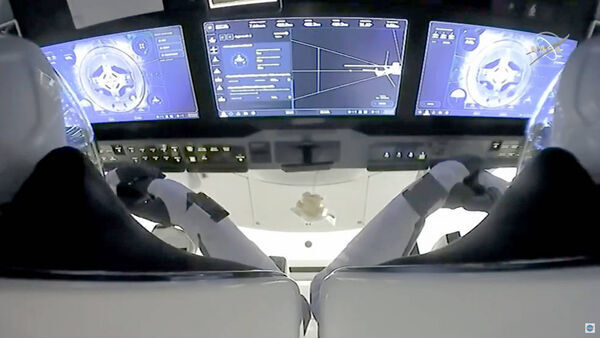
NASA’s SpaceX Crew-1 Astronauts Arrive at Space Station, NASA Leaders and Crew to Discuss Mission
"The SpaceX Crew Dragon Resilience successfully docked to the International Space Station at 11:01 p.m. EST Monday, transporting NASA astronauts Michael Hopkins, Victor Glover, Shannon Walker, and Japan Aerospace Exploration Agency (JAXA) astronaut Soichi Noguchi. When the hatches open about 1:10 a.m. Tuesday, Nov. 17, the Crew-1 astronauts will join Expedition 64 Flight Engineer Kate Rubins of NASA, and station Commander Sergey Ryzhikov and Flight Engineer Sergey Kud-Sverchkov of Roscosmos, who arrived to the station Oct. 14. NASA TV will continue to provide live coverage through the welcoming ceremony with NASA’s Associate Administrator for Human Exploration and Operations Kathy Lueders joining to greet the crew from the Mission Control Center at NASA’s Johnson Space Center in Houston, and JAXA President Hiroshi Yamakawa joining from the Tsukuba Space Center in Japan. The welcome ceremony is targeted to begin about 1:40 a.m. About 2 a.m., NASA will host a news conference following the welcome ceremony with the following participants: Kathy Lueders, associate administrator for human exploration and operations, NASA Headquarters Johnson Center Director Mark Geyer Ven Feng, deputy manager, NASA’s Commercial Crew Program Joel Montalbano, program manager, International Space Station All media participation will be remote; no media will be accommodated at any NASA site due to the COVID-19 pandemic. Media may ask questions by phone in the post-docking news conference Nov. 17 by calling the Johnson newsroom at 281-483-5111 no later than 1:50 a.m. On Thursday, Nov. 19, the four astronauts who are beginning the first crew rotation mission on the space station will join Rubins to answer questions in a news conference from the space station that will air live at 9:55 a.m. on NASA Television and the agency’s website. The crew will discuss its upcoming expedition, which increases the regular space station crew size from six to seven astronauts – adding to the crew time available for research – as well as their launch, rendezvous, and docking." [...]
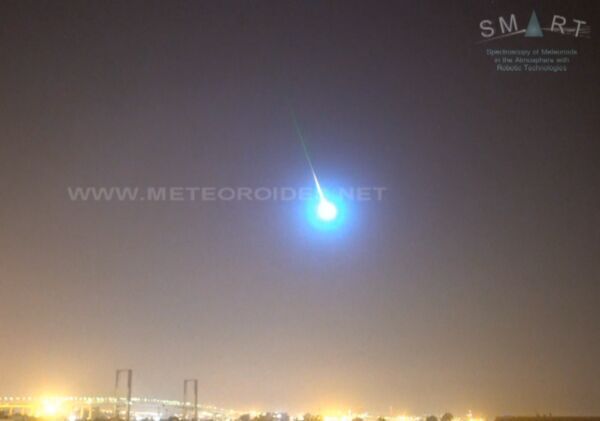
Fireball was destroyed over Évora district and explosion was seen more than 500km away
"The fireball was observed by a Spanish scientific project at a speed of 227,000 kilometers per hour. It was destroyed over the Évora district, but it was possible to see it in Porto. A fireball passed on Monday morning in the sky in the south of Portugal, where the light, caused by a meteorite, ended up extinguishing. The fireball, which traveled through the southwest of the Iberian Peninsula , was observed by a Spanish scientific project at a speed of 227,000 kilometers per hour. To Rádio Observador, the astrophysicist who observed the phenomenon explains that the fireball was destroyed over the district of Évora, but guarantees that it was possible to observe it in Porto. The event was detected by the sensors of the SMART project, of the Andalusian Astrophysics Institute (IAA-CSIC), of the astronomical observatories of Calar Alto (Almeria), Seville and La Hita (Toledo)." [...]
Outras Notícias
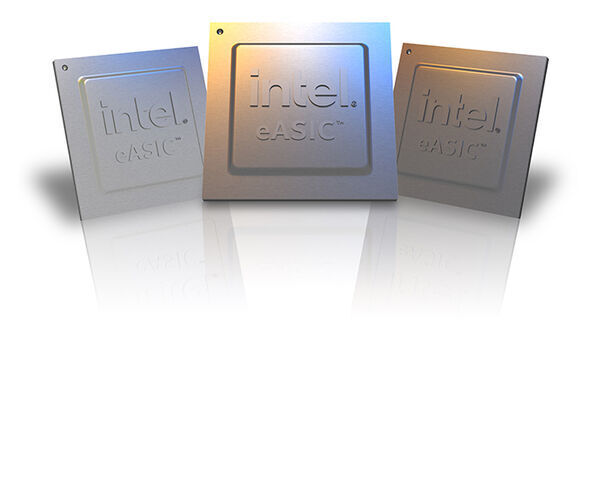
First Intel Structured ASIC for 5G, AI, Cloud and Edge Announced
"At Intel FPGA Technology Day, Intel announced a new, customizable solution to help accelerate application performance across 5G, artificial intelligence, cloud and edge workloads. The new Intel® eASIC N5X is the first structured eASIC family with an Intel® FPGA compatible hard processor system. The Intel eASIC N5X helps customers migrate both their custom logic and designs — using the embedded hard processor in the FPGA — to structured ASICs, bringing benefits like lower unit cost, faster performance and reduced power consumption. “The potential for data to transform industries and business has never been greater. The announcement of the new Intel eASIC N5X uniquely positions our customers to more fully benefit from the flexibility and time-to-market advantages of Intel FPGAs with the performance benefits and lower operating power of structured ASICs. The combination of FPGA, eASIC and ASIC products from Intel enables customers to take advantage of this potential by providing what we call the ‘custom logic continuum,’ and is a capability not available from any other vendor in the market.” –Dave Moore, Intel corporate vice president and general manager of the Programmable Solutions Group Why It Matters: FPGAs offer the best time-to-market advantage and highest flexibility for customer designs, while ASICs and structured ASIC devices provide the best hardware-optimized performance at the lowest power and cost." [...]

NVIDIA Doubles Down: Announces A100 80GB GPU, Supercharging World’s Most Powerful GPU for AI Supercomputing
"Leading Systems Providers Atos, Dell Technologies, Fujitsu, GIGABYTE, Hewlett Packard Enterprise, Inspur, Lenovo, Quanta and Supermicro to Offer NVIDIA A100 Systems to World’s Industries NVIDIA today unveiled the NVIDIA® A100 80GB GPU — the latest innovation powering the NVIDIA HGX™ AI supercomputing platform — with twice the memory of its predecessor, providing researchers and engineers unprecedented speed and performance to unlock the next wave of AI and scientific breakthroughs. The new A100 with HBM2e technology doubles the A100 40GB GPU’s high-bandwidth memory to 80GB and delivers over 2 terabytes per second of memory bandwidth. This allows data to be fed quickly to A100, the world’s fastest data center GPU, enabling researchers to accelerate their applications even faster and take on even larger models and datasets. “Achieving state-of-the-art results in HPC and AI research requires building the biggest models, but these demand more memory capacity and bandwidth than ever before,” said Bryan Catanzaro, vice president of applied deep learning research at NVIDIA. “The A100 80GB GPU provides double the memory of its predecessor, which was introduced just six months ago, and breaks the 2TB per second barrier, enabling researchers to tackle the world’s most important scientific and big data challenges.” The NVIDIA A100 80GB GPU is available in NVIDIA DGX™ A100 and NVIDIA DGX Station™ A100 systems, also announced today and expected to ship this quarter. Leading systems providers Atos, Dell Technologies, Fujitsu, GIGABYTE, Hewlett Packard Enterprise, Inspur, Lenovo, Quanta and Supermicro are expected to begin offering systems built using HGX A100 integrated baseboards in four- or eight-GPU configurations featuring A100 80GB in the first half of 2021." [...]

Microchip Delivers First 8-bit MCU Family for CAN FD Networks
"Automotive designers can now increase system capabilities with flexible and easy to use CIPs while connected to a high performing network. Meeting the demand for increased bandwidth and flexible data rates in evolving automotive applications like safety and communication, while further supporting the development of advanced driver-assistance systems (ADAS), Microchip Technology Inc. (Nasdaq: MCHP) today announced its PIC18 Q84 family — the first PIC18 microcontroller (MCU) family that can be used to transmit and receive data through a Controller Area Network Flexible Data-Rate (CAN FD) bus. Accompanied by an extensive array of Core Independent Peripherals (CIPs) that handle a variety of tasks without requiring CPU intervention, Microchip’s PIC18 Q84 family cuts both time and cost when connecting systems to a CAN FD network. news/News/2020/11/CT288 The family provides a simple solution for transporting sensor data to a CAN FD bus, without the need for gateways or sophisticated network switching techniques. In addition, its configurable CIPs make it easy to create custom hardware-based functions for automotive and industrial designs with near-zero latency. Additional code is not required." [...]

Meet the Microsoft Pluton processor – The security chip designed for the future of Windows PCs
"The role of the Windows PC and trust in technology are more important than ever as our devices keep us connected and productive across work and life. Windows 10 is the most secure version of Windows ever, built with end-to-end security for protection from the edge to the cloud all the way down to the hardware. Advancements like Windows Hello biometric facial recognition, built-in Microsoft Defender Antivirus, and firmware protections and advanced system capabilities like System Guard, Application Control for Windows and more have helped Microsoft keep pace with the evolving threat landscape. While cloud-delivered protections and AI advancements to the Windows OS have made it increasingly more difficult and expensive for attackers, they are rapidly evolving, moving to new targets: the seams between hardware and software that can’t currently be reached or monitored for breaches. We have already taken steps to combat these sophisticated cybercriminals and nation state actors with our partners through innovations like secured-core PCs that offer advanced identity, OS, and hardware protection. Today, Microsoft alongside our biggest silicon partners are announcing a new vision for Windows security to help ensure our customers are protected today and in the future." [...]

TI introduces industry's first automotive GaN FET with integrated driver, protection and active power management
"Engineers can deliver twice the power density and the highest efficiency in their automotive onboard chargers and industrial power supplies. Texas Instruments (TI) (Nasdaq: TXN) today expanded its high-voltage power management portfolio with the next generation of 650-V and 600-V gallium nitride (GaN) field-effect transistors (FETs) for automotive and industrial applications. With a fast-switching, 2.2-MHz integrated gate driver, the new families of GaN FETs help engineers deliver twice the power density, achieve 99% efficiency and reduce the size of power magnetics by 59% compared to existing solutions. TI developed these new FETs using its proprietary GaN materials and processing capabilities on a GaN-on-silicon (Si) substrate, providing a cost and supply-chain advantage over comparable substrate materials such as silicon carbide (SiC). For more information, see www.ti.com/LMG3425R030-pr and www.ti.com/LMG3525R030-Q1-pr. Vehicle electrification is transforming the automotive industry, and consumers are increasingly demanding vehicles that can charge faster and drive farther." [...]

Octonion Releases Expansion Package Dedicated to AI-Based Industrial Condition Monitoring on STMicroelectronics STM32 MCUs
"The solution enables industrial-equipment vendors to quickly evaluate Octonion’s embedded AI models, running on-device learning directly on STM32 MCUs OCTONION SA, a deep tech software company specializing in Artificial Intelligence (AI) at the Edge for industrial-equipment diagnosis, announced an STM32Cube expansion package optimized for STM32L4+ microcontroller-based industrial-application development boards from STMicroelectronics (NYSE: STM), a global semiconductor leader serving customers across the spectrum of electronics applications. Octonion’s new software package supports ST’s efforts to develop Artificial Intelligence-based applications running on STM32 microcontrollers and microprocessors in the fast-growing condition-based-monitoring and predictive-maintenance segments. The Octonion I-CUBE-OCTMI package delivers a self-care system running on STM32 ultra-low power MCUs and powered by Octonion’s Edge AI engine that automatically learns, inspects, and monitors the health of industrial equipment throughout its operating life. The expansion pack is optimized for the STM32L4+ development boards which include a range of ST’s industrial-grade sensors and connectivity features, starting from the STWIN SensorTile Wireless Industrial Node. It embeds Octonion’s AI engine operating in an unsupervised mode, continuously analyzing data from an accelerometer to handle vibration analysis for condition monitoring and predictive maintenance. The engine does not require any prior knowledge of the equipment or existing dataset." [...]

CircuitPython 6.0.0 released
"Download from circuitpython.org Downloads are available from circuitpython.org. The site makes it easy to select the correct file and language for your board. The downloads page is here. Downloads are no longer available from the GitHub release pages because of the large number of files for each release. (If you see the unstable release 6.0.0-rc.2 when you browse circuitpython.org, that release is older. Use this one.)" [...]

Vega Flight VV17: Source of anomaly identified; Inquiry Commission established
"Arianespace has announced the loss of the Vega VV17 mission, which was carrying two payloads: SEOSAT-Ingenio, an earth-science observation satellite for the European Spatial Agency (ESA); and TARANIS for France’s National Centre for Space Studies (CNES). Two and a half months after Vega’s successful return to flight, the Vega launch vehicle lifted off as scheduled on November 16 at 22:52 (local time in Kourou, French Guyana) from the Guyana Space Center. The first three stages functioned nominally until the ignition of the AVUM upper stage, eight minutes after departure from the launch pad. At that time, a degraded trajectory was detected, followed by a loss of control of the vehicle and the subsequent loss of the mission. The launcher fell in a completely uninhabited area close to the drop zone planned for the Zefiro 9 stage. Initial investigations conducted overnight with the available data identified a problem related to the integration of the fourth-stage AVUM nozzle activation system is the most likely cause of the loss of control of the launcher." [...]
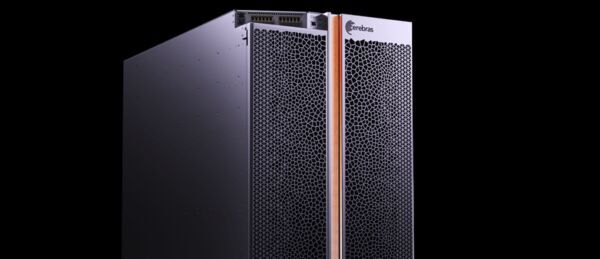
Beyond AI for Wafer Scale Compute: Setting Records in Computational Fluid Dynamics
"In collaborations with researchers at the National Energy Technology Laboratory (NETL), Cerebras showed that a single wafer-scale Cerebras CS-1 can outperform one of the fastest supercomputers in the US by more than 200 X. The problem was to solve a large, sparse, structured system of linear equations of the sort that arises in modeling physical phenomena—like fluid dynamics—using a finite-volume method on a regular three-dimensional mesh. Solving these equations is fundamental to such efforts as forecasting the weather; finding the best shape for an airplane’s wing; predicting the temperatures and the radiation levels in a nuclear power plant; modeling combustion in a coal-burning power plant; and or making pictures of the layers of sedimentary rock in places likely to contain oil and gas. Three key factors enabled the successful speedup: The memory performance on the CS-1. The high bandwidth and low latency of the CS-1’s on-wafer communication fabric. A processor architecture optimized for high bandwidth computing." [...]
Ciência e Tecnologia

New approach to circuit compression could deliver real-world quantum computers years ahead of schedule
"A major technical challenge for any practical, real-world quantum computer comes from the need for a large number of physical qubits to deal with errors that accumulate during computation. Such quantum error correction is resource-intensive and computationally time-consuming. But researchers have found an effective software method that enables significant compression of quantum circuits, relaxing the demands placed on hardware development. Quantum computers may still be far from a commercial reality, but what is termed "quantum advantage"-the ability of a quantum computer to compute hundreds or thousands of times faster than a classical computer-has indeed been achieved on what are called Noisy Intermediate-Scale Quantum (NISQ) devices in early proof-of-principle experiments. Unfortunately, NISQ devices are still prone to lots of errors that accumulate during their operation. For there to be any real-world application of quantum advantage, the design of a fully operational large-scale quantum computer with high error tolerance is required." [...]
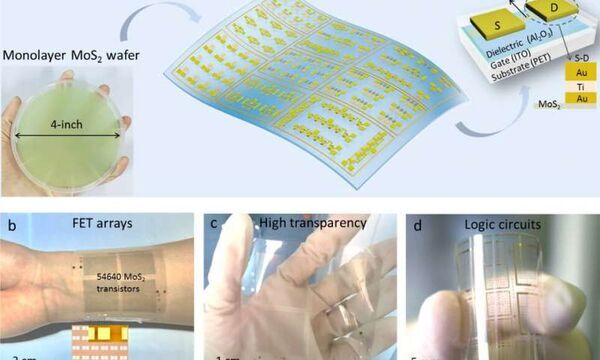
Flexible and transparent electronics fabricated using a two-dimensional semiconductor
"In recent years, engineers worldwide have been trying to create electronic components that are increasingly flexible and versatile, as this could enable the fabrication of more sophisticated devices and robotic systems, such as electronic skins (e-skins) or wearable sensors. The overall objective of this particular area of research is to develop flexible electronics that can be manufactured and implemented on a large scale, but that also exhibit a high device density and excellent performance. A class of materials with particular promise for developing flexible electronic parts are two-dimensional (2-D) semiconductors, such as molybdenum disulfide (MoS2). While this material has many advantageous mechanical, optical and electronic properties, it has so far proved challenging to build large-scale, flexible integrated circuits with a high device density and high performance using MoS2. Researchers at the Chinese Academy of Sciences have recently fabricated a new flexible and transparent MoS2-based transistor that could be manufactured on a large scale. This transistor, presented in a paper published in Nature Electronics, was created using a variant of the conventional vapor deposition process." [...]
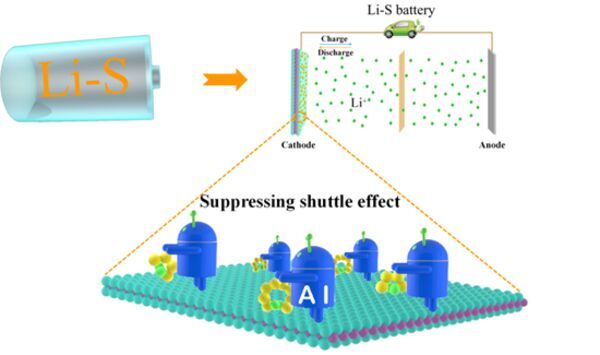
Breakthrough in Screening and Discovering Cathode Materials for Lithium-Sulfur Batteries
"Recently, a research team led by Li Jinjin from School of Electronic Information and Electrical Engineering, SJTU published their latest research findings in Energy Storage Materials (IF=16.28), a top journal in energy study. They proposed a machine learning method to rapidly and accurately predict the binding energies towards lithium polysulfides (LiPS), which greatly facilitated the screening and discovery of cathode materials for lithium-sulfur batteries. Their research greatly enhances the application of transfer learning in the area of complex materials by demonstrating that transfer learning can overcome the obstacle caused by a lack in material property data, which is of great importance to providing a general predicting model for research on the binding energies between two-dimensional layered materials and LiPS. " [...]
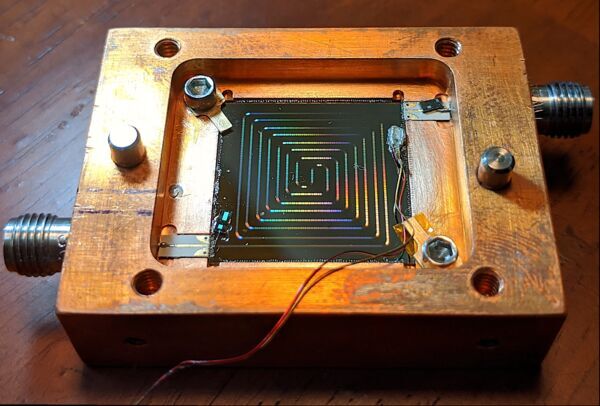
NIST Sensor Experts Invent Supercool Mini-Thermometer
"Researchers at the National Institute of Standards and Technology (NIST) have invented a miniature thermometer with big potential applications, such as monitoring the temperature of processor chips in superconductor-based quantum computers, which must stay cold to work properly. NIST’s superconducting thermometer measures temperatures below 1 kelvin (minus 272.15 C or minus 457.87 F), down to 50 millikelvin (mK) and potentially 5 mK. It is smaller, faster and more convenient than conventional cryogenic thermometers for chip-scale devices and could be mass produced. NIST researchers describe the design and operation in a new journal paper. Just 2.5 by 1.15 millimeters in size, the new thermometer can be embedded in or stuck to another cryogenic microwave device to measure its temperature when mounted on a chip. The researchers used the thermometer to demonstrate fast, accurate measurements of the heating of a superconducting microwave amplifier." [...]

Palladium, meet copper: Skoltech researchers use machine learning to improve catalysts
"Researchers from Skoltech and their colleagues from Germany and the US have studied the properties and behavior of a palladium-copper alloy under changing temperatures and hydrogen concentrations, with highly relevant implications of this research for catalyst design. The paper was published in the Journal of Applied Physics. Transition metal-alloy materials can have catalytic properties and are widely used in facilitating various chemical reactions such as CO2 hydrogenation, a process that turns carbon dioxide into methanol. Using an alloy of a more expensive reactive element with another one that is cheaper and more inert makes these catalysts highly efficient. One example of such a catalyst would be an alloy of palladium (Pd) and copper (Cu), where isolated atoms of Pd are positioned in the Cu lattice. Zhong-Kang Han, Debalaya Sarker and Sergey Levchenko of the Skoltech Center for Energy Science and Technology (CEST) and their colleagues modelled the properties of a Pd/Cu alloy, using a machine-learning model to predict the distribution of Pd atoms on a Cu surface as a function of hydrogen partial pressure and temperature." [...]

Quantifying Quantumness: A Mathematical Project ‘of Immense Beauty’
"Large objects, such as baseballs, vehicles, and planets, behave in accordance with the classical laws of mechanics formulated by Sir Isaac Newton. Small ones, such as atoms and subatomic particles, are governed by quantum mechanics, where an object can behave as both a wave and a particle. The boundary between the classical and quantum realms has always been of great interest. Research reported in AVS Quantum Science, by AIP Publishing, considers the question of what makes something “more quantum” than another — is there a way to characterize “quantumness”? The authors report they have found a way to do just that. The degree of quantumness is important for applications such as quantum computing and quantum sensing, which offer advantages that are not found in their classical counterparts." [...]

Quantum tunneling pushes the limits of self-powered sensors
"With just a 50-million-electron jumpstart, sensors can power themselves for more than a year. Shantanu Chakrabartty’s laboratory has been working to create sensors that can run on the least amount of energy. His lab has been so successful at building smaller and more efficient sensors, that they’ve run into a roadblock in the form of a fundamental law of physics. Sometimes, however, when you hit what appears to be an impenetrable roadblock, you just have to turn to quantum physics and tunnel through it. That’s what Chakrabartty and other researchers at the McKelvey School of Engineering at Washington University in St. Louis did. The development of these self-powered quantum sensors from the lab of Chakrabartty, the Clifford W. Murphy Professor in the Preston M. Green Department of Systems & Electrical Engineering, was published online Oct. 28 in the journal Nature Communications." [...]

Computer Scientists Launch Counteroffensive Against Video Game Cheaters
"University of Texas at Dallas computer scientists have devised a new weapon against video game players who cheat. The researchers developed their approach for detecting cheaters using the popular first-person shooter game Counter-Strike. But the mechanism can work for any massively multiplayer online (MMO) game that sends data traffic to a central server. Their research was published online Aug. 3 in IEEE Transactions on Dependable and Secure Computing. Counter-Strike is a series of games in which players work in teams to counter terrorists by securing plant locations, defusing bombs and rescuing hostages. Players can earn in-game currency to buy more powerful weapons, which is a key to success." [...]

Novel glass materials made from organic and inorganic components
"Research team from Jena and Cambridge develops glass materials with novel combinations of properties Linkages between organic and inorganic materials are a common phenomenon in nature, e.g., in the construction of bones and skeletal structures. They often enable combinations of properties that could not be achieved with just one type of material. In technological material development, however, these so-called hybrid materials still represent a major challenge today. A new class of hybrid glass materials Researchers from the Universities of Jena (Germany) and Cambridge (GB) have now succeeded in creating a new class of hybrid glass materials that combine organic and inorganic components. To do this, the scientists use special material combinations in which chemical bonds between organometallic and inorganic glasses can be generated. They included materials composed of organometallic networks – so-called metal-organic frameworks (MOFs) – which have recently been experiencing rapidly increasing research interest." [...]
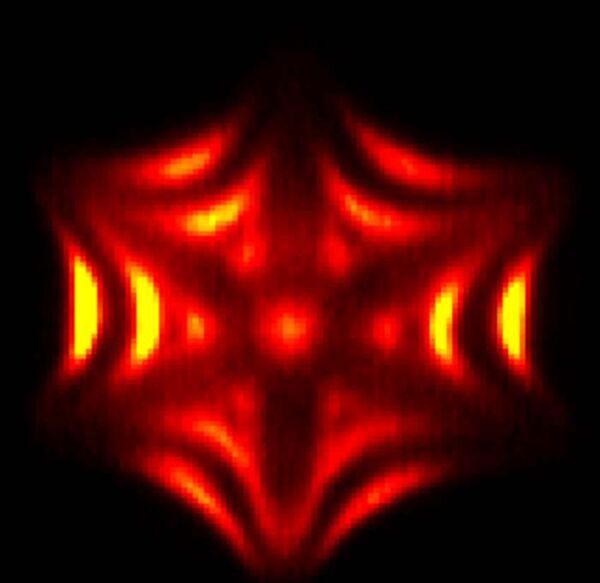
Germanium telluride's hidden properties at the nanoscale revealed
"Germanium Telluride is an interesting candidate material for spintronic devices. In a comprehensive study at BESSY II, a Helmholtz-RSF Joint Research Group has now revealed how the spin texture switches by ferroelectric polarization within individual nanodomains. Germanium telluride (GeTe) is known as a ferrolectric Rashba semiconductor with a number of interesting properties. The crystals consist of nanodomains, whose ferrolectric polarization can be switched by external electric fields. Because of the so-called Rashba effect, this ferroelectricity can also be used to switch electron spins within each domain. Germanium telluride is therefore an interesting material for spintronic devices, which allow data processing with significantly less energy input." [...]
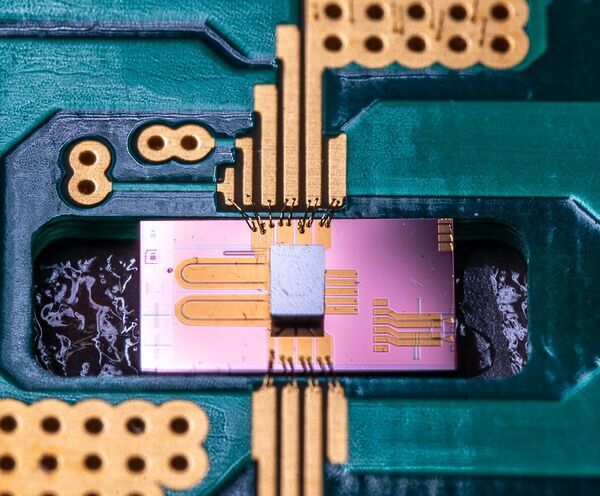
Southampton researchers develop world's first all-silicon optical transmitter at 100Gbps
"Silicon photonics researchers from the Optoelectronics Research Centre (ORC) have demonstrated the first all-silicon optical transmitter at 100Gbps and beyond without the use of digital signal processing. The optical modulator almost doubles the maximum data rate of current state-of-the-art devices, demonstrating the potential for low power low-cost all-silicon solutions that avoid complicating fabrication processes with new materials that are not CMOS compatible. The research team, led by Professor Graham Reed within the Zepler Institute for Photonics and Nanoelectronics, have published their findings in the Optical Society's prestigious journal Optica. The optical modulator is a critical component in systems serving modern information and communication technologies, not only in traditional data communication links but also in microwave photonics or chip-scale computing networks. Dr Ke Li, lead author and lead inventor on the technology's associated patents, says: "In contrast to previous work in the field, we have introduced a new design philosophy where photonics and electronics must be considered as a single integrated system in order to tackle the demanding technical challenges of this field." The new research was advanced within Southampton’s Silicon Photonics Group as part of the £6 million Engineering and Physical Sciences Research Council (EPSRC) Programme Grant Silicon Photonics for Future Systems." [...]

No losses: Scientists stuff graphene with light
"Physicists from MIPT and Vladimir State University, Russia, have achieved a nearly 90% efficiency converting light energy into surface waves on graphene. They relied on a laser-like energy conversion scheme and collective resonances. The paper came out in Laser & Photonics Reviews. Manipulating light at the nanoscale is a task crucial for being able to create ultracompact devices for optical energy conversion and storage. To localize light on such a small scale, researchers convert optical radiation into so-called surface plasmon-polaritons. These SPPs are oscillations propagating along the interface between two materials with drastically different refractive indices — specifically, a metal and a dielectric or air." [...]

System brings deep learning to “internet of things” devices
"Deep learning is everywhere. This branch of artificial intelligence curates your social media and serves your Google search results. Soon, deep learning could also check your vitals or set your thermostat. MIT researchers have developed a system that could bring deep learning neural networks to new — and much smaller — places, like the tiny computer chips in wearable medical devices, household appliances, and the 250 billion other objects that constitute the “internet of things” (IoT). The system, called MCUNet, designs compact neural networks that deliver unprecedented speed and accuracy for deep learning on IoT devices, despite limited memory and processing power. The technology could facilitate the expansion of the IoT universe while saving energy and improving data security." [...]

New fiber optic sensors transmit data up to 100 times faster
"Fiber optic sensors – used in critical applications like detecting fires in tunnels, pinpointing leaks in pipelines and predicting landslides – are about to get even faster and more accurate. EPFL engineers have developed an advanced encoding and decoding system that allows fiber optic sensors to send data up to 100 times faster and over a wider area. “Unlike conventional sensors that take measurements at a given point, like thermometers, fiber optic sensors record data all along a fiber,” says Luc Thévenaz, a professor at EPFL’s School of Engineering and head of the Group for Fibre Optics (GFO). “But the technology has barely improved over the past few years.” Used widely in safety applications Fiber optic sensors are commonly used in hazard detection systems, such as to spot cracks in pipelines, identify deformations in civil engineering structures and detect potential landslides on mountain slopes. The sensors can take temperature readings everywhere a fiber is placed, thereby generating a continuous heat diagram of a given site – even if the site stretches for dozens of kilometers. That provides crucial insight into possible accidents before they happen." [...]

Manchester group discovers new family of quasiparticles in graphene-based materials
"A group of researchers led by Sir Andre Geim and Dr Alexey Berdyugin at The University of Manchester have discovered and characterised a new family of quasiparticles named ‘Brown-Zak fermions’ in graphene-based superlattices. The team achieved this breakthrough by aligning the atomic lattice of a graphene layer to that of an insulating boron nitride sheet, dramatically changing the properties of the graphene sheet. The study follows years of successive advances in graphene-boron nitride superlattices which allowed the observation of a fractal pattern known as the Hofstadter’s butterfly – and today (Friday, November 13) the researchers report another highly surprising behaviour of particles in such structures under applied magnetic field. “It is well known, that in a zero magnetic field, electrons move in straight trajectories and if you apply a magnetic field they start to bend and move in circles”, explain Julien Barrier and Dr Piranavan Kumaravadivel, who carried out the experimental work. “In a graphene layer which has been aligned with the boron nitride, electrons also start to bend – but if you set the magnetic field at specific values, the electrons move in straight line trajectories again, as if there is no magnetic field anymore!” “Such behaviour is radically different from textbook physics.” adds Dr Piranavan Kumaravadivel. “We attribute this fascinating behaviour to the formation of novel quasiparticles at high magnetic field,” says Dr Alexey Berdyugin." [...]

A 2D Perspective: Stacking Materials to Realize a Low Power Consuming Future
"Scientists devise a 2D-material–based stacked structure with applications in reducing computing power consumption Scientists have designed a 2D material-based multi-stacked structure comprising tungsten disulfide (WS2) layer sandwiched between hexagonal boron nitride (hBN) layers that displays long-range interaction between successive WS2 layers with potential for reducing circuit design complexity and power consumption. 2D materials have been popular among materials scientists owing to their lucrative electronic properties, allowing their applications in photovoltaics, semiconductors, and water purification. In particular, the relative physical and chemical stability of 2D materials allow them to be “stacked” and “integrated” with each other. In theory, this stability of 2D materials enables the fabrication of 2D material-based structures like coupled “quantum wells” (CQWs), a system of interacting potential “wells,” or regions holding very little energy, which allow only specific energies for the particles trapped within them. CQWs can be used to design resonant tunneling diodes, electronic devices that exhibit a negative rate of change of voltage with current and are crucial components of integrated circuits. Such chips and circuits are integral in technologies that emulate neurons and synapses responsible for memory storage in the biological brain." [...]

St Petersburg University scientists discover a new mineral that looks promising for producing batteries
"The research team headed by Stanislav Filatov, Professor at the Department of Crystallography at St Petersburg University, has discovered a new mineral species in Kamchatka – petrovite. The scientists named the find in honour of Tomas Petrov, an outstanding crystallographer and Professor at St Petersburg University. He together with his students Arkady Glikin and Sergei Moshkin, was the first in the world to create a technology for growing jewellery malachite. For more than 40 years, Stanislav Filatov, Professor at St Petersburg University, together with colleagues from other research institutions in Russia, has been studying the mineralogy of scoria cones and lava flows of fumaroles in Kamchatka. They were formed after two major eruptions of Tolbachik Volcano – in 1975-1976 and 2012-2013. This territory is unique in its mineralogical diversity." [...]
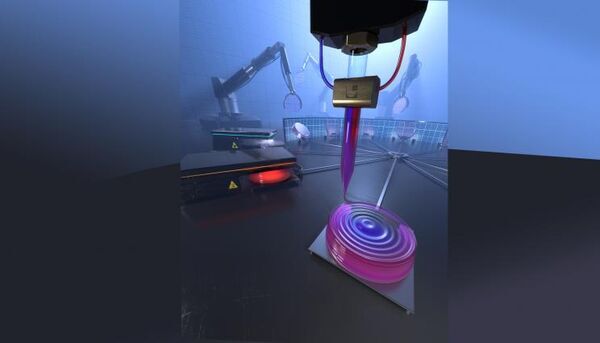
3D-printed glass enhances optical design flexibility
"Lawrence Livermore National Laboratory (LLNL) researchers have used multi-material 3D printing to create tailored gradient refractive index glass optics that could make for better military specialized eyewear and virtual reality goggles. The new technique could achieve a variety of conventional and unconventional optical functions in a flat glass component (with no surface curvature), offering new optical design versatility in environmentally stable glass materials. The team was able to tailor the gradient in the material compositions by actively controlling the ratio of two different glass-forming pastes or “inks” blended together inline using the direct ink writing (DIW) method of 3D printing. After the composition-varying optical preform is built using DIW, it is then densified to glass and can be finished using conventional optical polishing. “The change in material composition leads to a change in refractive index once we convert it to glass,” said LLNL scientist Rebecca Dylla-Spears, lead author of a paper appearing today in Science Advances. The project started in 2016 when the team began looking at ways that additive manufacturing could be used to advance optics and optical systems." [...]

Quantum molecular switches operate by hydrogen tunneling with some help
"The quantum dynamics of hydrogen is central to many problems in nature, being strongly influenced by the environment in which it takes place. In their contribution to PRL, members of the Lise Meitner Group at the MPSD address hydrogen transfer within a supported molecular switch, showing that the surface support can play a decisive role in the tunneling reaction. In the constant quest to miniaturize technological components, molecule-based nanotechnology becomes an ever-growing field of interest. In this field, single molecules become the fundamental components of electronic devices. The sheer variety of possible molecular architectures and the possibility of precisely manipulating molecular synthesis opens the door to endless functional components. However, the key challenge is to gain control over these functions in the nanoscale, where quantum mechanical effects become prominent." [...]

New process narrows the gap between natural and synthetic materials
"Skin and cartilage are both strong and flexible – properties that are hard to replicate in artificial materials. But a new fabrication process, developed by scientists at EPFL, brings lifelike synthetic polymers a step closer. Natural materials like skin, cartilage and tendons are tough enough to support our bodyweight and movements, yet flexible enough that they don’t crack easily. Although we take these properties for granted, replicating this unique combination in synthetic materials is much harder than it sounds. Now, scientists at EPFL have developed a new way of making strong, supple composite polymers that more closely mimic materials found in the natural world. Their breakthrough, described in a paper appearing in Advanced Functional Materials, could have applications in fields such as soft robotics and cartilage prosthetic implants." [...]

Arecibo Observatory Telescope to be Decommissioned After Second Cable Break
"The National Science Foundation expects it will be several weeks before disassembly of the telescope can begin. Following a review of engineering assessments, the U.S. National Science Foundation today announced it will begin planning the controlled decommissioning of the 1,000-foot-wide telescope at the Arecibo Observatory in Puerto Rico. The observatory, which UCF manages for NSF under a cooperative agreement, has for 57 years served as a world-class resource for radio astronomy and planetary, solar system and geospace research. But a main cable break on Nov. 6 caused the structural integrity of the telescope to come into question. Three engineering firms, which had been previously hired to address an auxiliary cable break at the facility in August, assessed the telescope and submitted their reports to NSF. The engineer of record, Thornton Tomasetti, recommended decommissioning of the telescope because it found the telescope structure is in danger of a catastrophic failure." [...]
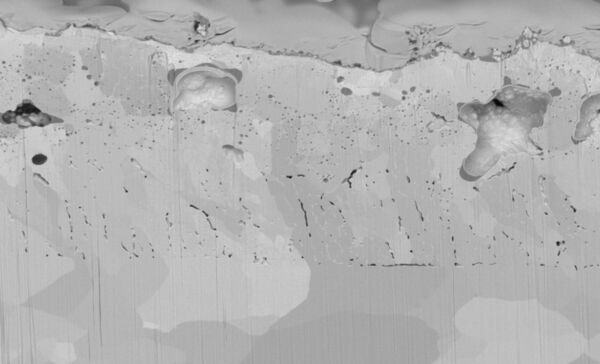
Tungsten develops layers under fusion reactor extreme heat conditions
"In tokamaks, magnetic confinement devices being explored for use as nuclear fusion reactors, anomalous events can cause a transfer of energy with 10 million times the intensity of the solar radiation on Earth’s surface. These events can cause damage to structural components, potentially threatening the longevity of a tokamak. Penn State researchers recently published a paper on simulating these conditions in the laboratory, without use of a tokamak, to investigate the effects of such an extreme heat load on tungsten. They published their findings in npj Materials Degradation on Oct. 2. “To make fusion power really work instead of just working theoretically, we need to understand how some materials will survive better than others,” said Leigh Winfrey, associate professor in the Ken and Mary Alice Lindquist Department of Nuclear Engineering. “This research gives us a better understanding of the problem.” When a tokamak operates, high-energy plasma flows through its chamber in a donut-like shape, bounded by magnetic fields so the plasma — often at temperatures of several hundred million degrees Fahrenheit — does not touch the tokamak walls." [...]
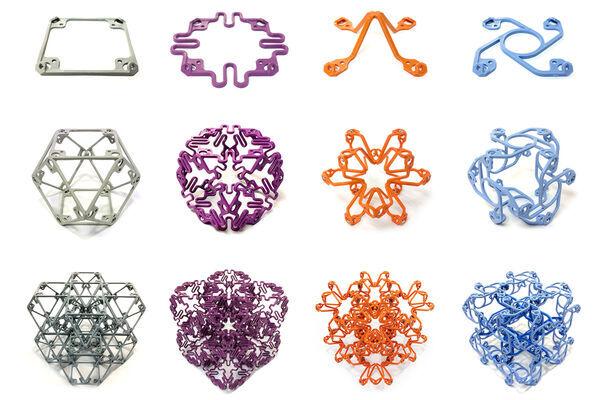
Versatile building blocks make structures with surprising mechanical properties
"The subunits could be robotically assembled to produce large, complex objects, including cars, robots, or wind turbine blades. Researchers at MIT’s Center for Bits and Atoms have created tiny building blocks that exhibit a variety of unique mechanical properties, such as the ability to produce a twisting motion when squeezed. These subunits could potentially be assembled by tiny robots into a nearly limitless variety of objects with built-in functionality, including vehicles, large industrial parts, or specialized robots that can be repeatedly reassembled in different forms. The researchers created four different types of these subunits, called voxels (a 3D variation on the pixels of a 2D image). Each voxel type exhibits special properties not found in typical natural materials, and in combination they can be used to make devices that respond to environmental stimuli in predictable ways. Examples might include airplane wings or turbine blades that respond to changes in air pressure or wind speed by changing their overall shape." [...]
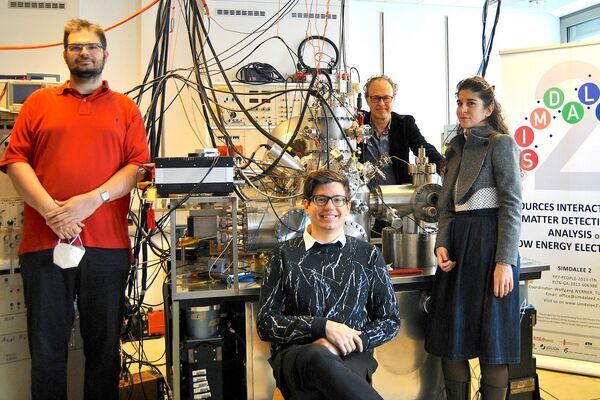
Old Mystery Solved: a "New Kind of Electrons"
"Why do certain materials emit electrons with a very specific energy? This has been a mystery for decades – scientists at TU Wien have found an answer. It is something quite common in physics: electrons leave a certain material, they fly away and then they are measured. Some materials emit electrons, when they are irradiated with light. These electrons are then called "photoelectrons". In materials research, so-called "Auger electrons" also play an important role - they can be emitted by atoms if an electron is first removed from one of the inner electron shells." [...]

Researchers develop ultra-fast polymer modulators that can take the heat
"Silicon-polymer hybrid modulators capable of optical data rates of 200 Gbit/s at temperatures up to 110 °C could help reduce datacenter cooling costs Datacenters could benefit from lower cooling costs in part to ultra-fast electro-optic modulators developed by researchers in Japan using a polymer that is stable even at temperatures that would boil water. Reported in the journal Nature Communications, the silicon-polymer hybrid modulators can transmit 200 gigabits of data per second at up to 110 °C and could enable optical data interconnections that are both extremely fast and reliable at high temperatures, reducing the need for cooling and expanding applications in harsh environments like rooftops and cars. Demand for high-speed data transmission such as for high-definition media streaming has exploded in recent years, and optical communications are central to many of the necessary data connections. A critical component is the modulator, which puts data on a beam of light passing through an electro-optic material that can change its optical properties in response to an electric field. Most modulators currently use inorganic semiconductors or crystals as the electro-optic material, but organic-based polymers have the advantages that they can be fabricated with excellent electro-optic properties at a low cost and operated at low voltages. “Polymers have great potential for use in modulators, but reliability issues still need to be overcome for many industry applications,” explains Shiyoshi Yokoyama, professor of Kyushu University’s Institute for Materials Chemistry and Engineering and leader of the research collaboration." [...]

Dark-matter candidate could display stringy effects in the lab
"Calculations show how theoretical ‘axionic strings’ could create odd behavior if produced in exotic materials in the lab A hypothetical particle that could solve one of the biggest puzzles in cosmology just got a little less mysterious. A RIKEN physicist and two colleagues have revealed the mathematical underpinnings that could explain how so-called axions might generate string-like entities that create a strange voltage in lab materials1. Axions were first proposed in the 1970s by physicists studying the theory of quantum chromodynamics, which describes how some elementary particles are held together within the atomic nucleus. The trouble was that this theory predicted some bizarre properties for known particles that are not observed. To fix this, physicists posited a new particle—later dubbed the axion, after a brand of laundry detergent, because it helped clean up a mess in the theory. Physicists soon realized axions could clear up a cosmic conundrum too." [...]
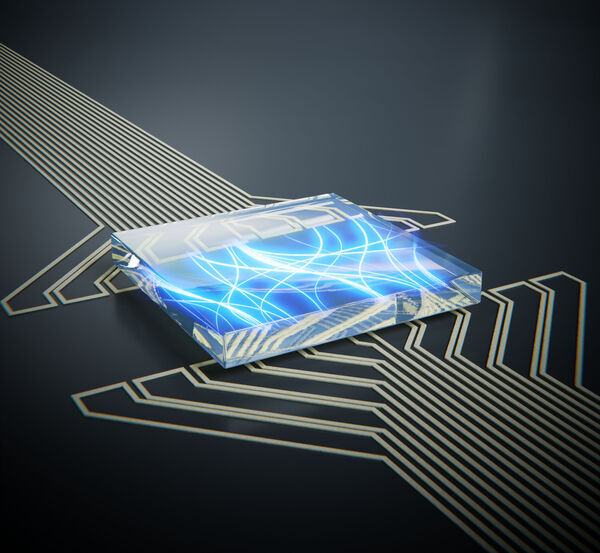
Researchers create MRI-like technique for imaging magnetic waves
"A team of researchers from Delft University of Technology (TU Delft), Leiden University, Tohoku University and the Max Planck Institute for the Structure and Dynamics of Matter has developed a new type of MRI scanner that can image waves in ultrathin magnets. Unlike electrical currents, these so-called ‘spin waves’ produce little heat, making them promising signal carriers for future green ICT applications. MRI scanners can look into the human body in a non-invasive manner. The scanner detects the magnetic fields radiated by the atoms inside, which makes it possible to study the health of organs even though they are hidden underneath thick layers of tissue. The non-invasive, see-through power of MRI is desirable for many research fields and industries. It could be particularly useful as an imaging tool in nanotechnology and the chip industry." [...]
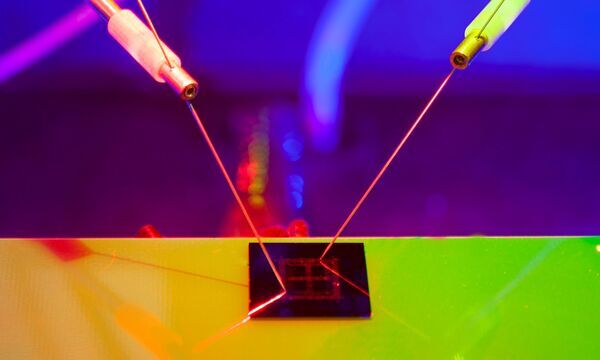
New electronic chip delivers smarter, light-powered AI
"Researchers have developed artificial intelligence technology that brings together imaging, processing, machine learning and memory in one electronic chip, powered by light. The prototype shrinks artificial intelligence technology by imitating the way that the human brain processes visual information. The nanoscale advance combines the core software needed to drive artificial intelligence with image-capturing hardware in a single electronic device. With further development, the light-driven prototype could enable smarter and smaller autonomous technologies like drones and robotics, plus smart wearables and bionic implants like artificial retinas. The study, from an international team of Australian, American and Chinese researchers led by RMIT University, is published in the journal Advanced Materials. Lead researcher Associate Professor Sumeet Walia, from RMIT, said the prototype delivered brain-like functionality in one powerful device." [...]

Seeking the Most Effective Polymers for Personal Protective Equipment
"Personal protective equipment, like face masks and gowns, is generally made of polymers. But not much attention is typically given to the selection of polymers used beyond their physical properties. To help with the identification of materials that will bind to a virus and speed its inactivation for use in PPE, researchers from the University of Nottingham, EMD Millipore, and the Philipps University of Marburg developed a high-throughput approach for analyzing the interactions between materials and viruslike particles. They report their method in the journal Biointerphases, from AIP Publishing. “We’ve been very interested in the fact that polymers can have effects on cells on their surface,” said Morgan Alexander, an author on the paper. “We can get polymers, which resist bacteria, for example, without designing any particular clever or smart material with antibiotic in there." [...]
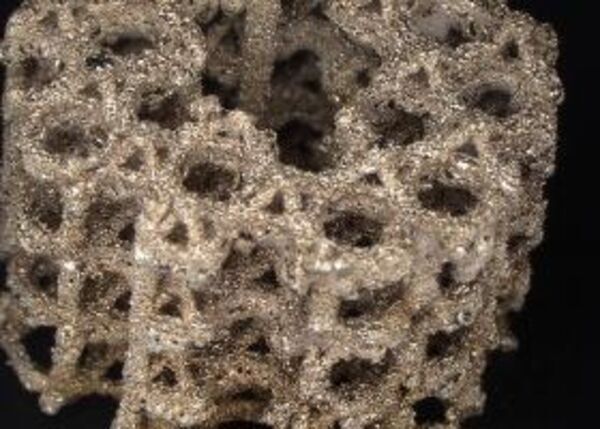
3D printed silver implants help tackle infections
"An interdisciplinary team of researchers from the University of Wolverhampton and the University of Sussex are investigating the possibility of 3D printing patient-specific silver- based implants to reduce infection and antimicrobial resistance. Despite substantial advances in invasive surgery and aseptic techniques, implant-related infection remains an all too common complication. The team, Dr Arun Arjunan, John Robinson, Dr Enas Al Ani, Dr Wayne Heaselgrave, Dr Ahmad Baroutaji and Dr Chang Wang, reported that 3D printed silver implants and tissue engineering scaffolds provides antibacterial protection, while featuring complex porous architecture, suitable for patient-specific tissue reconstruction. Dr Arun Arjunan, Reader in Additive Manufacturing of Functional Materials at the University of Wolverhampton, said: “Millions of people across the world suffer from inflammatory and degenerative diseases associated with bone and joints requiring implants where infection is a serious complication resulting in pain, mortality, prolonged recovery, and antimicrobial resistance. Therefore, reducing the risk of infection associated with tissue implants requires imminent attention, where pure silver offers enormous potential. “Although the idea of using silver as an antibacterial agent is not necessarily new, this research is the first step towards developing 3D printed silver based infection resistant porous implants." [...]

Scientists age quantum dots in a test tube
"Researchers from MIPT and the RAS Institute of Problems of Chemical Physics have proposed a simple and convenient way to obtain arbitrarily sized quantum dots required for physical experiments via chemical aging. The study was published in Materials Today Chemistry. Colloidal quantum dots are nanosized crystals whose size determines the frequency at which they emit and absorb electromagnetic radiation. They are used in solar cells, TV sets, fire alarm systems, and more. The MIPT Laboratory for Photonics of Quantum Nanostructures conducts research using lead sulfide quantum dots. The conventional approach to their synthesis, known as hot injection, involves mixing two so-called precursors — compounds containing lead and sulfur — under particular conditions." [...]
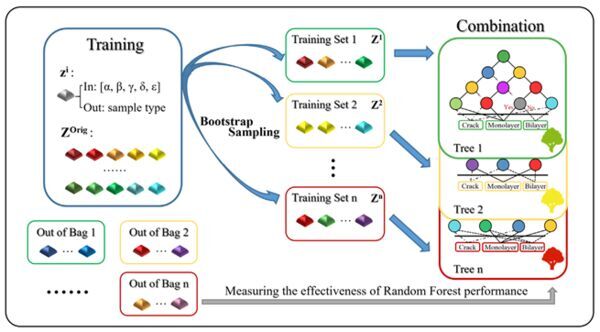
Scientists Propose Machine Learning Method on 2D Material Spectroscopy
"Machine learning is an important branch in the field of artificial intelligence. Its basic idea is to build a statistical model based on data and use the model to analyze and predict the data. With the rapid development of big data technology, data-driven machine learning algorithms have begun to flourish in various fields of materials research. Recently, a research team led by Prof. WANG Jun from the Shanghai Institute of Optics and Fine Mechanics of the Chinese Academy of Sciences (CAS) proposed a recognition method to distinguish the monolayer continuous film and random defect areas of two-dimensional (2D) semiconductors using the machine learning method with Raman signals. Their work revealed the application potential of machine learning algorithms in the field of 2D material spectroscopy, and was published in Nanomaterials. The Raman spectrum of 2D materials is very sensitive to molecular bonding and sample structure, and can be used for research and analysis of chemical identification, morphology and phase, internal pressure/stress, and composition." [...]
Documentação
A documentação é parte essencial do processo de aprendizagem e a Internet além de artigos interessantes de explorar também tem alguma documentação em formato PDF interessante de ler. Todos os links aqui apresentados são para conteúdo disponibilizado livremente pelo editor do livro.
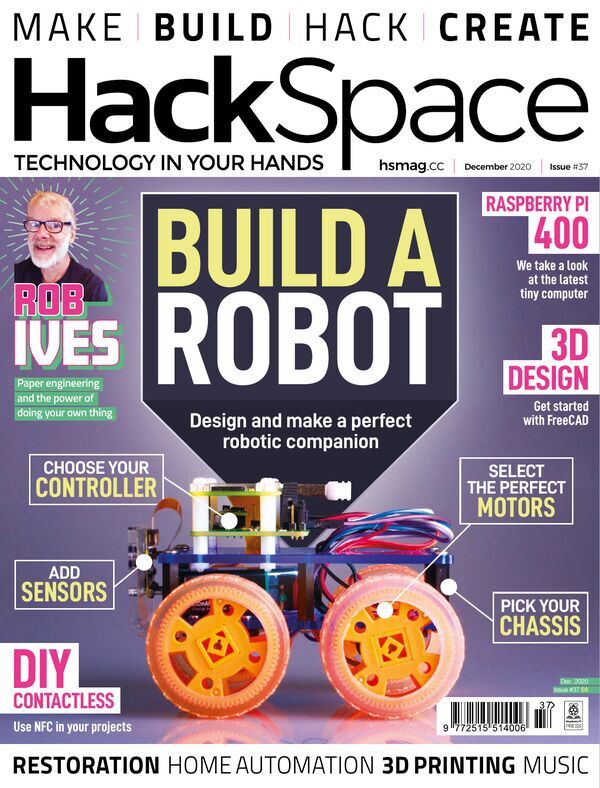
HackSpace magazine #37
"Robots were supposed to make our lives easier, but where are they? Well, it turns out that if you want to have your own electronic companion, you're probably going to have to make it yourself. This issue, we take a look at how to start your own journey to electro-mechanical mastery. We'll show you how to pick the perfect bits for your robot and put them together. What you do with it is up to you. " [...]
Projetos Maker
Diversos Projetos interessantes.

CO2 Wall Clock
"Arduino powered CO2 Monitor for Schools, Offices, and Private Buildings Proper ventilation not only ensures well-being, but significantly reduces risk of SARS-CoV-2 infection “Aerosols are a possible transmission path of the novel coronavirus. Aerosols spread quickly throughout the entire room, especially in closed indoor spaces. Regular ventilation by shock and cross ventilation or via ventilation systems can significantly reduce the risk of infection with SARS-CoV-2.” [Source] Every person is emitting CO2 as well as aerosols while breathing. CO2 concentration correlates with the aerosol and thus virus concentration. CO2 is also a good indicator for the efficiency of the ventilation. Why a CO2 Monitor?" [...]
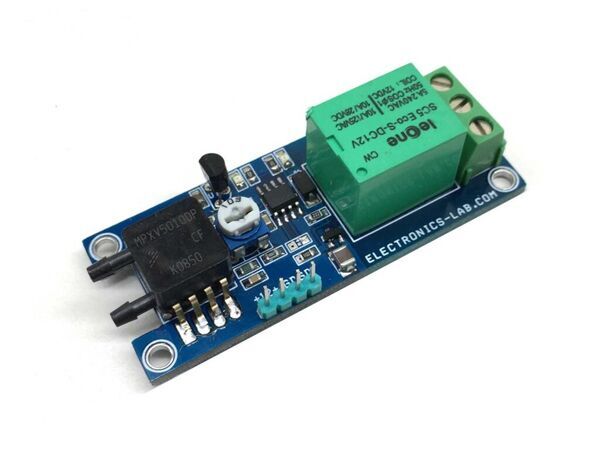
Liquid or Air Pressure Switch with Relay
"This pressure switch project is built using a piezoresistive transducer, LM358 OPAMP as comparator, and a relay. The circuit activate the relay when the pressure in a system exceed a given set-point. Basically, this switch can power ON or OFF a pump, valve, motor, when certain pressure is reached. A trimmer potentiometer is provided to set the trigger point. LM358 is used as comparator, relay has Normally Open/Normally closed contacts with current rating 5Amps @ 230V AC or 10Amps @ 28V DC. LM78L05 IC is used to provide 5V DC supply to pressure sensor." [...]

LEET Synthesizer
"LEET is my vision of a new kind of modular affordable synth you can build yourself. It consists of several MIDI devices that can be used together or separate with your preferred DAW. It became a massive project covering industrial design, embedded programming, 3D modelling, electronics and music theory. I’m happy with the current state, but I hope that with the help of others, the project will continue to evolve and improve. I have designed a keyboard, drum pad, chord keyboard, control unit, arpeggiator and a step sequencer. One special feature is that the units have RGB LEDs for each key, enabling playback visualization (so each device is both MIDI out and in)." [...]

Reverse-engineering the classic MK4116 16-kilobit DRAM chip
"Back in the late 1970s, the most popular memory chip was Mostek's MK4116, holding a whopping (for the time) 16 kilobits. It provided storage for computers such as the Apple II, TRS-80, ZX Spectrum, Commodore PET, IBM PC, and Xerox Alto as well as video games such as Defender and Missile Command. To see how the chip is implemented I opened one up and reverse-engineered it. I expected the circuitry to be similar to other chips of the era, using standard NMOS gates, but it was much more complex than I expected, built from low-power dynamic logic. The MK4116 also used advanced manufacturing processes to fit 16,384 high-density memory cells on the chip.12 I created the die photo below from multiple microscope images. The white lines are the metal wiring on top of the chip, while the silicon underneath appears dark red." [...]

Cute & Elegant Domino Clock
"My Clock design is a simplified version of the Domino Wall Clock by Carbon Design Group. I have made it smaller to put it on a table or in a shelf and simplified the mechanism that shows the time. Instead of using electronic magnetic coil motors to reveal the white dots; what is if not complicated is tedious and a bit expensive, mine uses WS2812B 5050 Addressable SMD smart RGB Leds to show the time. Supplies: 1 x Arduino Nano 1 x RTC I2C DS1307 AT24C32 42 x WS2812B 5050 Addressable RGB Leds 3mm MDF Board 3mm White Acrylic Board 3mm Grey Translucent Smoke Acrylic Board (Fume 02)" [...]

buck50: Test and measurement firmware for "Blue Pill" STM32F103
"buck50 is open-source firmware that turns a "Blue Pill" STM32F103 development board (widely available for approx. US$1.50) into a multi-purpose test and measurement instrument, including: - 8 channel, 6+ MHz logic analyzer - Approx. 5K sample buffer depth - Samples stored only at signal edges for efficient memory usage - Units may be ganged for increased number of channels - Complex triggering via user-defined state machine supporting combinations of sequential ("A then B then C") and logical-OR ("A or B or C") conditionals - Output to VCD and other file formats for export to waveform viewing software 1 - Live monitoring and logging of digital, analog, USART (sync/async), SPI (MOSI/MISO), and I2C (master/slave/TX/RX) data - Simple dual-channel approx. 1 MHz digital storage oscilloscope, approx. 5K sample buffer depth (10K if single channel) - 3 channel digital pulse train generator with user-defined frequency and per-channel duty cycle and polarity - Bidirectional bridge/converter from USART/UART (async/synchro), SPI (master/slave), or I2C ... to USB ... to host terminal, UNIX socket, or UNIX pty device file - 8-bit parallel output counter (binary or gray code) - Host terminal ascii or binary input data to 8-bit parallel output - Firmware written in a combination of C++ and ARM Thumb-2 assembly code, with several non-standard hacks^H^H^H^H^Htechniques of possible general interest to advanced software developers - Python host driver program with comprehensive inline help system and usability features - Coffee maker attachment sold separately, not included in base price 2" [...]

3D Printed Guitar That Lights Up As You Play
"Several years ago I built a CNC router with the express purpose of creating my own guitar. Unfortunately however, I never got around to it. Two years back I was getting into 3D printing in a big way and started thinking… What if I 3D printed a guitar? Well, that led me on a journey of making my own 3D printer big enough to print a guitar body. Keep reading to see how I built a 3D printed guitar, that also lights up when you play it! " [...]

Digital Level Using Arduino Nano & MPU6050
"Everyone needs a level at some point whether you are a pro or just hanging a shelf on a wall you want to make sure that it’s going to be straight! Let’s create an accurate Digital Level that works in both the Horizontal (LEVEL) plane, Vertical (PLUMB) plane as well as angles in between like a 45. These would be the same 3 bubble indicators you would have on any decent level you purchase at the hardware store. We’ve built in some nice features and housed it all in a nice 3D printed enclosure that looks like any standard level, printed in what I call DeWalt Yellow (But it’s really Hatchbox brand Yellow PLA!) - Automatic rotating screen so that the view of the angle is always readable to you even if you flip it completely upside down. Like how your phone screen flips as you rotate it." [...]
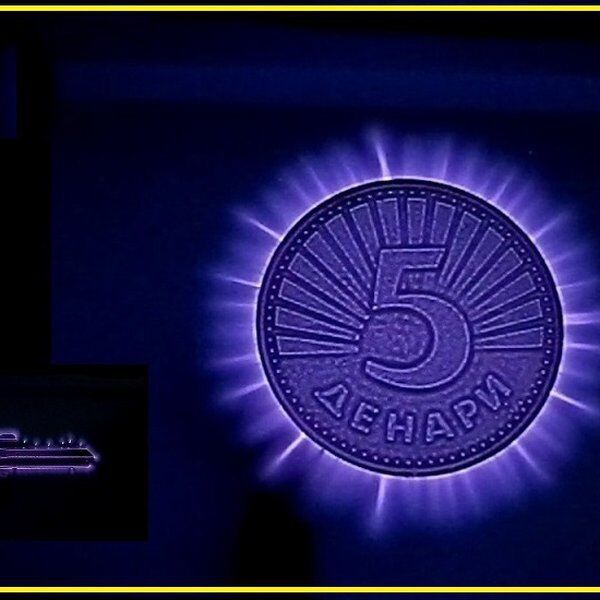
DIY a High Voltage Kirlian photography device
"Kirlian photography is named after Semyon Davidovich Kirlian who began his work with high voltage photography in 1939. If an object on a photographic plate is connected to a high-voltage source, an image is produced on the photographic plate. You can use a transparent electrode instead of a plate and capture the images with any modern digital camera. This case is described in the video above. The device basically consists of two parts: Transparent Discharge Plate and High Voltage Power Supply. The transparent plate is a glass around which a container is formed by means of a plastic or other frame of insulator." [...]
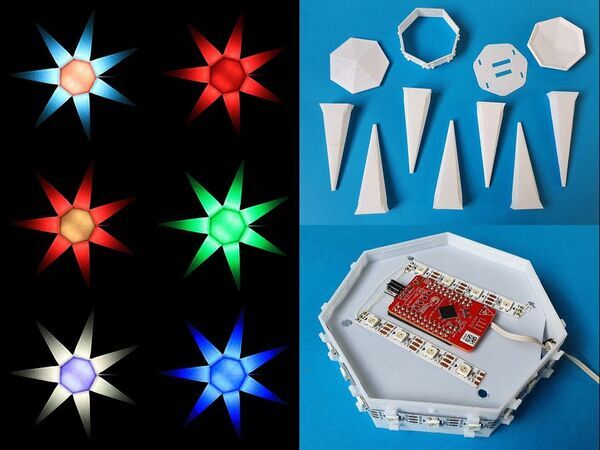
StripLightStar
"Illuminated 7-point-star: A combined 3D-printing and electronics project using WS2812B based striplights for seasonal decoration. Story Out from my former projects with WS2812b based stripligths I focused this time on the 3D printing part to give my electronics a nice case: A 7-point-star to be used for the seasonal decoration. The electronics, again, Cypress PSoC4BLE, and its firmware allows to address individual colors for the points and the body of the star. The program sequencer runs some color effects defined by the user. Further, the star can be controlled via BLE, same as the firmware can be upgraded Over-the-Air (OTA). Let us see some details... 3D-construction The complete star consists of eleven 3D-printed parts: 7 x Star Points (Choose 15, 17 or 19 cm length) 1 x Star Body (approx." [...]

Motorized Slide Potentiometer Driver
"This motorized slide potentiometer is used in lighting and Audio/Video equipment or other similar application. It is a simple solution to control a motorized slide potentiometer using two tactile switches or a microcontroller interface. The project includes bidirectional motor driver L293DD H-Bridge chip, LM555 timer IC to generate the PWM pulse for speed control and two tactile switches to control the direction of the motor. Instead of two tactile switches, these pins can be interfaced with Arduino or microcontroller. SW2 and SW3 are used for CCW/CW motor control. PR1 trimmer potentiometer is provided to set the motor speed." [...]
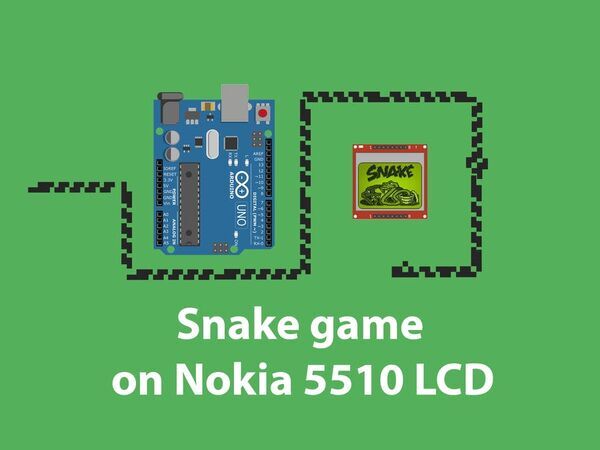
Snake Game on Nokia 5510 LCD
"Legendary Snake game on Nokia LCD again! Sounds, high score and settings menu also included. Summary I had Nokia LCD screen for some time, and few days ago, I decided to create functionally legendary Snake game with Arduino Uno, few buttons and piezo speaker for sounds. Functionalities: Main menu with 3 options: Play, Settings and High score Settingsmenu: control contrast, backlight and game sounds Sounds - play tones on Game over and eating High score - preserve high score" [...]

Quinary LED Art Clock
"This quinary ( base 5 ) LED clock project has taken me many more months than I thought it would. I spent a great deal of time considering and ruminating over exactly how I wanted it to look and operate. It's gone through many, many, many iterations but is finally in a 'done' enough state that I feel quite happy with it and ready to write about it and possibly move on to other things in my life. It began first with the concept of utilizing addressable ws2812b LED strips to indicate the time in an alternate base. I've worked on binary clocks a few times in the past but have grown a little tired of the concept, and I wanted to create something that would make more efficient use of fewer LEDs so that I could power them directly from an esp8266 without worrying about drawing too much power from the board itself and burning it out. I like the simplicity of not providing additional current, and I wanted to see how much utility I could sneak out of these power limitations." [...]
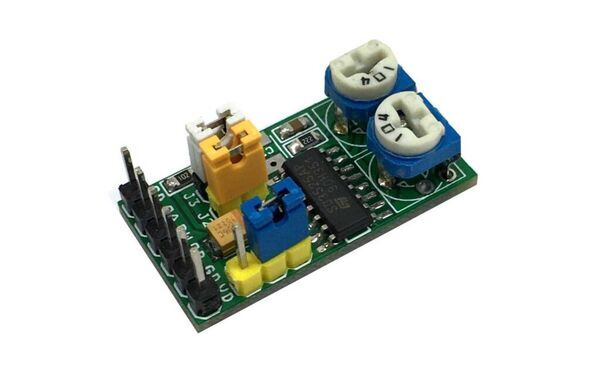
PWM Module with Dual Source/Sink Outputs using SG3525
"SG3525 PWM module is a great tool for every hobbyist. This circuit can be used in various applications such as switching power supply, DC-DC converter, DC motor speed controller, LED dimer, High voltage power supply, solenoid driver, and electronic DC load. This low-cost pulse width modulator control circuit offers improved performance. The circuit has various options such as adjustable PWM, adjustable frequency, optional soft start, dual source/sink output with 50% duty cycle, single output with 0 to 100% duty cycle and output signal voltage level TTL-5V or 12V selection using a jumper. The 5V PWM signal is rated at low current hence don’t draw more than 20mA. The 12V outputs are capable to drive a MOSFET directly." [...]
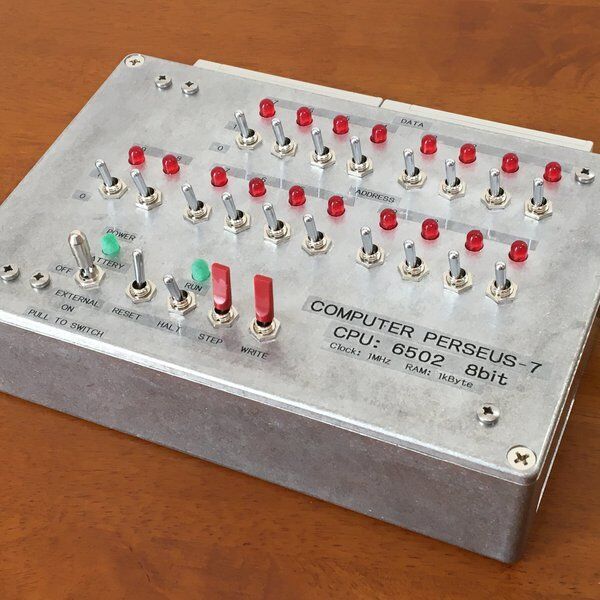
6502 standalone computer
"A minimal 6502 computer that can be programed machine language without PCs I have developed a minimal 6502 computer that can be programed machine language without PCs. The concept is the following three. (1) Minimize the number of peripheral standard logic ICs to simplify the circuit. (2) Manually single instruction execution is possible and the execution address is displayed at that time. (3) To make the housing strong enough so that anyone other than me can easily operate it. 1." [...]

Temperature Meter/Thermometer with NTC and OLED Display
"Yet another temperature monitoring setup with NTC, SSD1306 OLED and NodeMCU A thermistor is a resistance thermometer or a resistor whose resistance is dependent on temperature. The term is a combination of “thermal” and “resistor”. It is made of metallic oxides, pressed into a bead, disk, or cylindrical shape and then encapsulated with an impermeable material such as epoxy or glass. There are two types of thermistors: Negative Temperature Coefficient (NTC) and Positive Temperature Coefficient (PTC). With an NTC thermistor, when the temperature increases, resistance decreases. Conversely, when the temperature decreases, resistance increases." [...]
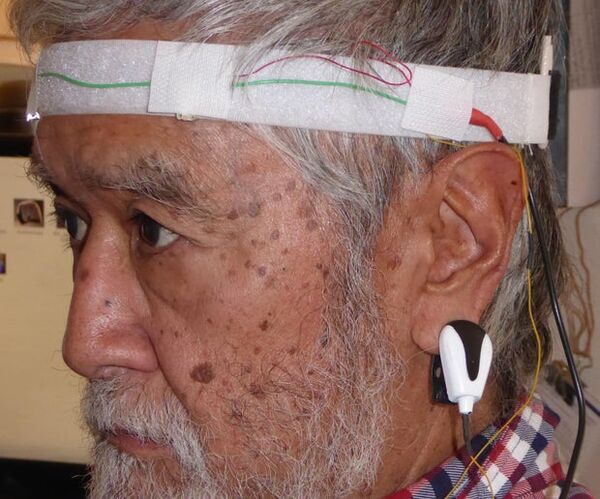
EEG AD8232 Phase 2
"So this Lazy Old Geek (L.O.G.) built an EEG: https://www.instructables.com/id/EEG-AD8232-Phase-... It seems to work okay but one of the things I dont like about it is being tethered to a computer. I use that as an excuse to not do any testing. Another concern I have is that it seems like Im getting some AC power line noise in my signal. During some earlier testing I saw mysterious 40Hz spike that seems to go away when I disconnect the USB and ran it on battery." [...]

Night Light Motion & Darkness Sensing - No Micro
"This instructable is about preventing you from stubbing your toe when walking through a dark room. You could say it is for your own safety if you get up at night and try to reach the door safely. Of course you could use a bedside lamp or the main lights because you have a switch right next to you, but how confortable is it, to dazzle your eyes with a 60W light bulb when you just woke up? Its about a LED-strip you mount underneath your bed that is controlled by two sensors which detect motion and the level of darkness in your room. It will run at low power and brightness to provide a very pleasant light at night. There is also the capability for controlling the brightness-threshold to make it suitable for every environment." [...]

App Controlled Colour Cloud
"Hi, in this instructable I show you how to build a room lighting from a gravel path grid. The whole thing can be controlled via WLAN with an app. There were some problems with the project. But in the end you can make it without special tools. Patience, some courage and time. Supplies: White Heavy Duty Gravel Grid Wemos D1 mini Soldering stuff adressable RGB-LEDs a baseplate (i've used 3mm plywood a diffusor (i've used very thin white plastic sheet) Lots of very small screws (or a very good and suitable glue) drillpress makes it much easier cutting tools" [...]

4-20ma Generator/Tester Using Arduino
"4-20mA generators are available on ebay, but I for one love the DIY part of things and using parts I have laying around. I wanted to test our PLC’s analog inputs to verify our scada readings and to test the output of 4-20mA instruments. There are loads of current to voltage converters and voltage to current converters for arduino on ebay, they need calibration though. I can use this to calibrate any of those converters found on ebay and the likes. I decided that I will DIY a generator and tester. At this point in time it is still a work in progress and a prototype." [...]

Raspberry Pi Shutdown Indicator
"It’s very simple circuit for showing operational status of raspberry pi (Hereinafter as RPI). Maybe it’s useful when you running RPI as headless (without monitor). Sometimes I’m concerned when is right time for completely power-off after shutdown RPI. Therefore, this circuit is made to notify the right time for power-off. Also it can show you the headless running RPI doing something.. at least make bi-color LED blinking. (Circuit introduction) This circuit is made base on very common LED multi-vibrator so called as LED blinker." [...]
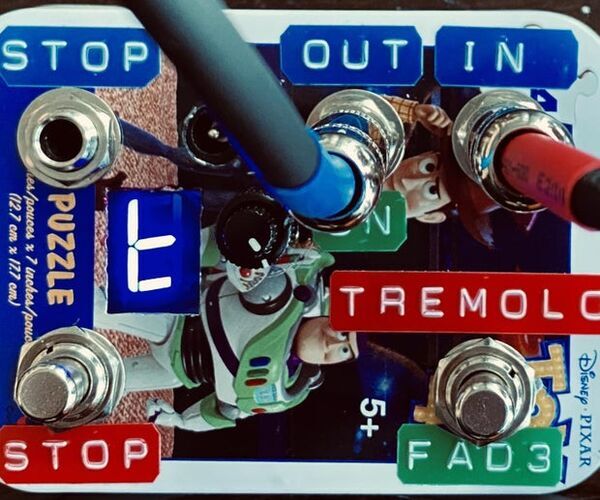
Guitar Looper Fade Out and Tremolo... for Free!
"Once upon a time, when electric guitar had to sound like a guitar and every deviation was called unwanted distortion, there were no guitar effects except... your friend and the potentiometer, working together! Practically while you were playing, your friend was energetically moving up and down the volume generating the universally named Tremolo effect (well, not universally: Mr. Fender confused Tremolo with Vibrato and vice versa!). I started this project with the simple intention to add the feature of FADE to my Boss RC-1 Looper Station: I like to play some simple riff and improvise on (...I hate play on MIDI bases or pre-recorded materials!) but some tunes can be stopped very nicely synchronised with your playing, some are better if faded away. The option of FADE is not really very common on Looper. I have the DITTO x4 but my experience with its lack of reliability has forced me to go back to my Boss RC-1!" [...]

ZazHRM - a Bluetooth Heart Rate Monitoring System for Sleep Time
"ZazHRM is being developed to try to perform heart rate monitoring (HRM) during sleep time. This prototype broadcasts via Bluetooth (BT), in near real time, a measure of the heart rate (HR) or the pulse signal to an Android phone in a 10 meter radius. The App running on the android phone, among other things, enables the visualization of either the HR or the pulse. When the HR falls below or rises above predefined thresholds, the App can also send a alarm. The Android app was developed with AppInventor, the pulse signal is captured by a PulseSensor, the BT communication is performed by a HC-05 BT module, and the C/C++ code orchestrating the whole thing runs on an Arduino Uno. A Python script also shows how to perform basic offline processing of the data accumulated during monitoring." [...]
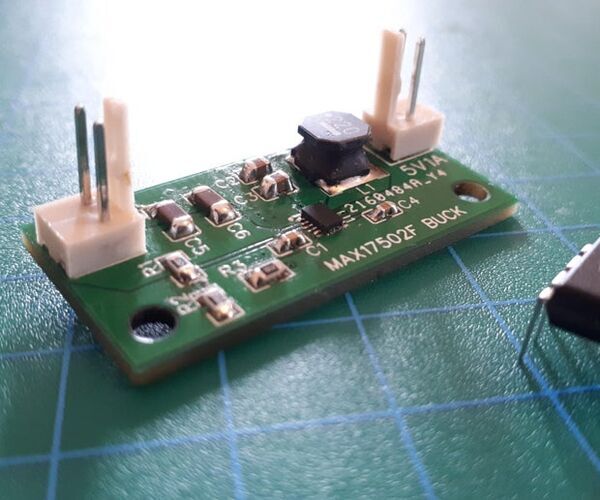
DIY High Efficiency 5V Output Buck Converter!
"I wanted an efficient way of stepping down higher voltages from LiPo packs (and other sources) to 5V for electronics projects. In the past I have used generic buck modules from eBay, but the questionable quality control and no name electrolytic capacitors did not fill me with confidence. So, I decided that I would make my own step down converter to not only challenge myself but to make something useful also! What I ended up with is a buck converter that has a very wide input voltage range (6V up to 50V input) and outputs 5V at up to 1A load current all in a small form factor. The peak efficiency I measured was 94% so not only is this circuit small but it stays cool too. " [...]
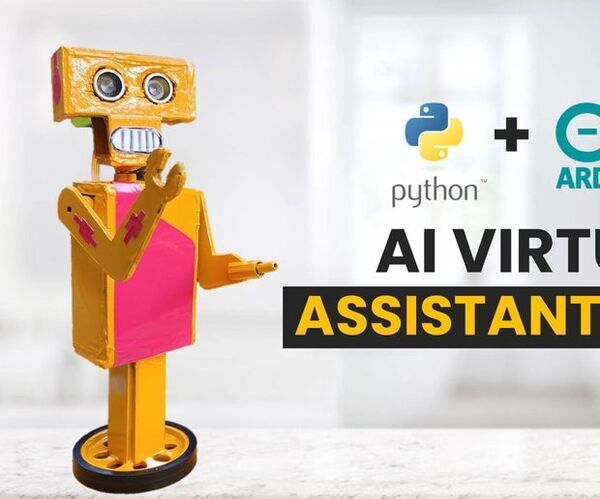
Jaundice- Your AI Assistant Robot
"We all are familiar with Jarvis AI assistant robot from Iron Man movies and Marvel series. It has always been a dream of programmers to make something on their own. I will today show a simple way to make such an assistant using Python programming. Moreover, I will also make a physical avatar of that robot, so that whenever we talk to the robot, it can do some movements. That will be more amazing than just a software robot. Because if it has a body, it is cool." [...]

IOT Based Weather Reporting System to Find Dynamic Climatic
"How to make an IOT Weather Reporting System using Arduino and Node MCU" [...]
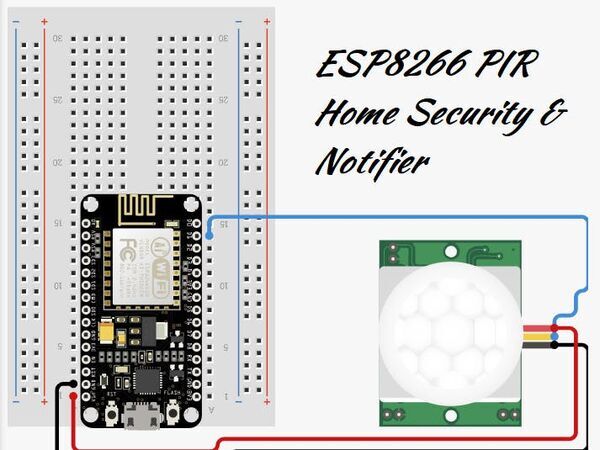
ESP8266 PIR Home Security & Notifier
"A Smart Home Security System which send email and mobile notification when a intruder is detected! Introduction In this project we use ESP8266 in its NodeMCU form factor as a home security device which with the help of PIR sensor senses the movement of intruder and sends and email and mobile notification to the owner along with the time. What is PIR Sensor? A passive infrared sensor PIR sensor is an electronic sensor that measures infrared (IR) light radiating from objects in its field of view. They are most often used in PIR-based motion detectors. PIR sensors are commonly used in security alarms and automatic lighting applications hence we would be using it." [...]
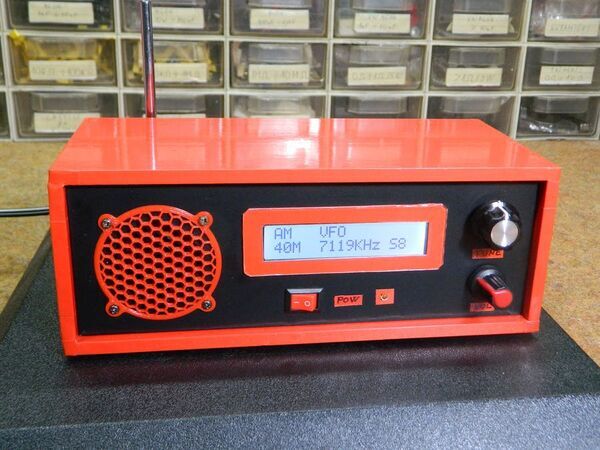
Homemade Arduino , Si4730 All Band Receiver (LW, MW, SW, FM)
"Nice little all-band radio easy to build. This inexpensive receiver is capable of receiving the entire radio broadband spectrum, from 200KHz up to 108MHz. If you are using a SI4735-D60 or SI4732-A10 based circuit, you can also use this sketch to add the SSB functionality. Otherwise the hardware is completely identical to the one in the previous video, only the color of the case has been changed to know that the new menu makes it completely different and more functional. Overview Things Story Schematics Code Credits Comments(1) 6 Mirko Pavleski Mirko Pavleski Published November 13, 2020 © GPL3+ Homemade Arduino , Si4730 All Band Receiver (LW, MW, SW, FM) Nice little all-band radio easy to build. Intermediate Full instructions provided 5,649 Homemade Arduino , Si4730 All Band Receiver (LW, MW, SW, FM) Things used in this project Hardware components Arduino Nano R3 Arduino Nano R3 × 1 Si4730 cheap Radio module from Aliexpress × 1 Standard LCD - 16x2 White on Blue Adafruit Standard LCD - 16x2 White on Blue × 1 Ferite rod from old AM radio × 1 Rotary Encoder with Push-Button Rotary Encoder with Push-Button × 1 D-class audio amplifier board 3+3W with potentiometer × 1 Story This is a continuation of the all-band receiver (https://www.youtube.com/watch?v=zPlVdLj5gFg), based on the SI4730-D60 radio module that can be purchased on aliexpress for only $ 2." [...]
That's all Folks!



